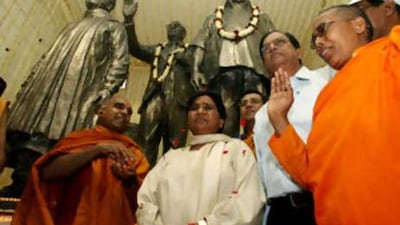NEW DELHI // Though both may be small in stature and full in figure, Mayawati, the controversial chief minister of Uttar Pradesh, one of India's poorest states, is no doubt hoping the similarities between her and Queen Victoria do not end there. Mayawati, who has set her sights on becoming India's first Dalit - or "untouchable" - prime minister, has commissioned a 50-foot bronze statue of herself to be modelled on the British monarch, who also had the title "Empress of India".
Mayawati has already earned herself the regal moniker "Dalit Queen" because of her low caste and her popularity among the 160 million Dalits in India, who still endure prejudice and the denial of basic rights more than half a century after discrimination on the grounds of caste was outlawed. The statue, one of 40 sculptor Shraavan Prajapati has made of Mayawati, will show the five-foot politician in a seated position and will be based on a marble representation of Queen Victoria housed in a museum in Lucknow, Uttar Pradesh's capital.
The statue's starting price is 425 million rupees (Dh37m) but Mr Prajapati said the final cost could be closer to 700m rupees as the cost of materials is rising. "Apart from being bedecked in jewels and a crown, the statue has grace and powerfulness - the essence of being a ruler, that is why we thought of emulating it for Mayawati," Mr Prajapati said in an interview with The National. The statue is the largest and most expensive Mayawati - who goes by only one name - has commissioned since Mr Prajapati began making sculptures of her in 1993, highlighting her growing political clout and ambition ahead of nationwide elections next year.
A foretaste of the power Mayawati could wield came last month when a no-confidence vote was called after leftist parties withdrew their support for the government in protest over its decision to push ahead with a civilian nuclear energy agreement with the US. Mayawati's Uttar Pradesh-based Bahujan Samaj Party then joined forces with the Communists and other parties to create a second opposition in parliament.
The government narrowly survived the vote, but analysts said Mayawati emerged as the ultimate winner having boosted her national profile enough to give Congress or the main opposition party, the Bharatiay Janata Party, a run for their money in the next national polls. "At the next election a whole host of smaller political parties will be jostling for seats, and Mayawati's party could emerge as a front-runner," said Ajoy Bose, who has written a biography of Mayawati.
"She has a potential constituency all over the country," Mr Bose said. While it is unlikely her party would win more seats than other more established parties, a win of 40 seats to 50 seats for the BSP could mean she helps decide which of the two main parties would form a government by entering in to a coalition with them. Some analysts think she might even be able to wrangle the premiership for herself, a post she has said she would be interested in occupying. Her stronghold in Uttar Pradesh, India's most populous state, will help her realise that ambition with 80 of the 543 seats in the lower house reserved for the state. Of India's 13 prime ministers, eight have come from Uttar Pradesh.
The daughter of a clerk from the Chamar, or leather handling caste, and an illiterate mother, Mayawati used affirmative-action programmes designed to help India's downtrodden to train as a teacher and then as a lawyer. But since first becoming chief minister in Uttar Pradesh for a short period in 1995, she has been dogged by scandals and allegations of corruption. Last year the Indian government reopened an investigation into her "disproportionate assets", after she declared she was worth 520m rupees ahead of the state elections.
Only three years earlier she said she was worth 110m rupees. The increase she said was from supporters who had gifted her with money, art and jewellery. In 2003, she was also caught up in a corruption scandal surrounding plans to build a shopping mall next to the Taj Mahal, which is located at Agra, also in Uttar Pradesh. Opponents accuse her of squandering public funds that are desperately needed to repair the state's shoddy roads and overhaul the struggling electricity grid.
Some critics estimate she has spent 22 billion rupees on statues and other monuments over the past 13 years. In June, she ordered officials to remove a 12-foot statue of her in Lucknow and replace it with one three-feet taller so it would be the same height as other statues nearby. Mr Bose said the real reason may have been that the sculptor forgot to include her trademark handbag. Mr Prajapati, who provided the replacement, said Mayawati insists it is incorporated in all of her statues.
The total cost of the exchange, which was carried out in the middle of the night, was estimated to be 950,000 rupees. But rather than dent her standing in the eyes of the poor and repressed, the erection of statues has only enhanced her popularity, Mr Bose said. "Dalits are unique - unlike other oppressed groups they were denied even the gods. The temples were closed to them," Mr Bose said. "They had no icons, so these statues have become their totems. They feel this is their due."
@Email:hgardner@thenational.ae

